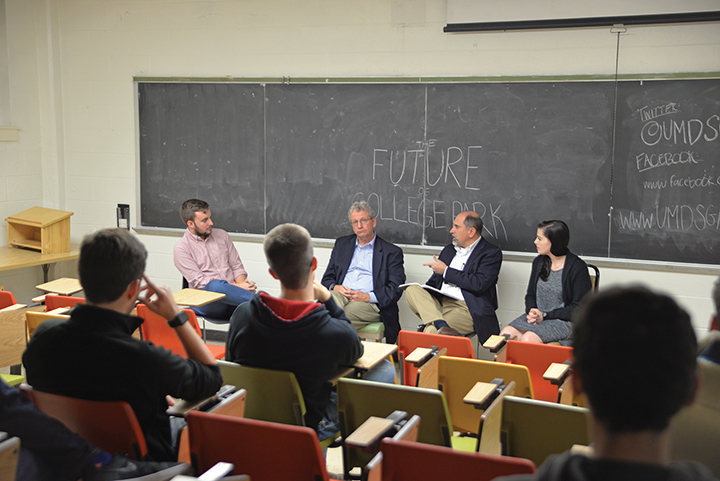The SGA held a Town Hall meeting Tuesday, giving University of Maryland students an opportunity to ask questions and learn more about the future of College Park.
During the meeting, about 30 students — mainly involved in the SGA — directed their questions to the panel guests, which included Eric Olson, executive director of the College Park City-University Partnership, former College Park Mayor Andrew Fellows, SGA President Katherine Swanson and A.J. Pruitt, the SGA’s vice president of student affairs.
As part of the Greater College Park and University District Vision 2020 initiatives, the University of Maryland, the City of College Park, the state of Maryland and Prince George’s County are collaborating to transform this city into a top-20 college town by 2020, according to the College Park Partnership’s website.
Many students have approached Swanson regarding rumors of what’s coming to this city, she said, specifically with questions about how the local community will be affected.
“I just want people to know exactly what’s coming,” Swanson said. “I want their questions about our future of becoming a better college town to be answered, [and be] able to give feedback to the people who are working on these things directly.”
Pruitt opened the meeting by asking Fellows and Olson a variety of questions, specifically concerning the city’s lack of coffee shops — which is a common staple among many college towns — as well as the expensive rates of student housing.
Olson replied by listing upcoming College Park projects such as the Art House, which is opening sometime next year, the coffee shop and wine bar opening on Baltimore Avenue and the arts and entertainment hall, which is slated to open sometime in the late spring or early summer of 2017.
In terms of student housing, both Fellows and Olson agreed there needs to be more affordable student housing, also adding that it’s something he hears a lot about from undergraduate students.
“It’s tricky because we have a market,” Olson said. “Increase the supply then the prices will come down, [but] we haven’t seen it all happen yet. … With real estate prices being so high [then] developers have to charge a certain amount; It’s a dance.”
Pruitt added that the city council’s relationship with students is not as strong as it could be. Sometimes it feels like the city’s leaders are more focused on what permanent residents want, and don’t consider students’ opinions and desires, he said.
“There’s a tendency to think of students as coming and going,” Fellows said, “but they come for a few years and then they’re gone … It’s easy for elected officials to lose sight that they represent everybody including the short term residents equally.”
Pruitt ended his questioning with an issue he said has not improved in this city: parking. However, Olson countered this point and said that parking has improved, citing the parking garage located in downtown College Park built about six years ago.
“The ultimate solution … we want to create the most walkable urbanized town possible,” Olson said. “When the purple line comes through it’s supposed to take 7-something thousand cars off the road.”
Despite these issues, Fellows and Olson said they believe College Park is well on its way to becoming a top college town.
“Things are going phenomenally in College Park,” Olson said. “Dr. Loh and the council agreed on the University District Vision 2020 … We outlined a number of goals to work in housing and development, transportation, public safety, education and sustainability, and among those goals, we’ve accomplished a lot in not even five years.”
Students also opted to voice their concerns during the meeting, with some referencing potential gentrification in regard to retaining small businesses, housing expenses and the walkability of Route 1.
Other students said they had heard rumors about which restaurants, businesses and retailers will be relocating to College Park — including the potential relocation of the FBI headquarters to Greenbelt. And while it wasn’t mentioned at this meeting, Swanson said she’s had at least six people ask her about a Dunkin’ Donuts potentially opening on Route 1.
“Everyone wants a Dunkin’ Donuts on Route 1,” Swanson said. “People want grocery stores, people [are] asking about the hotel, but mostly people know things are changing but they’re not sure what’s happening.”



